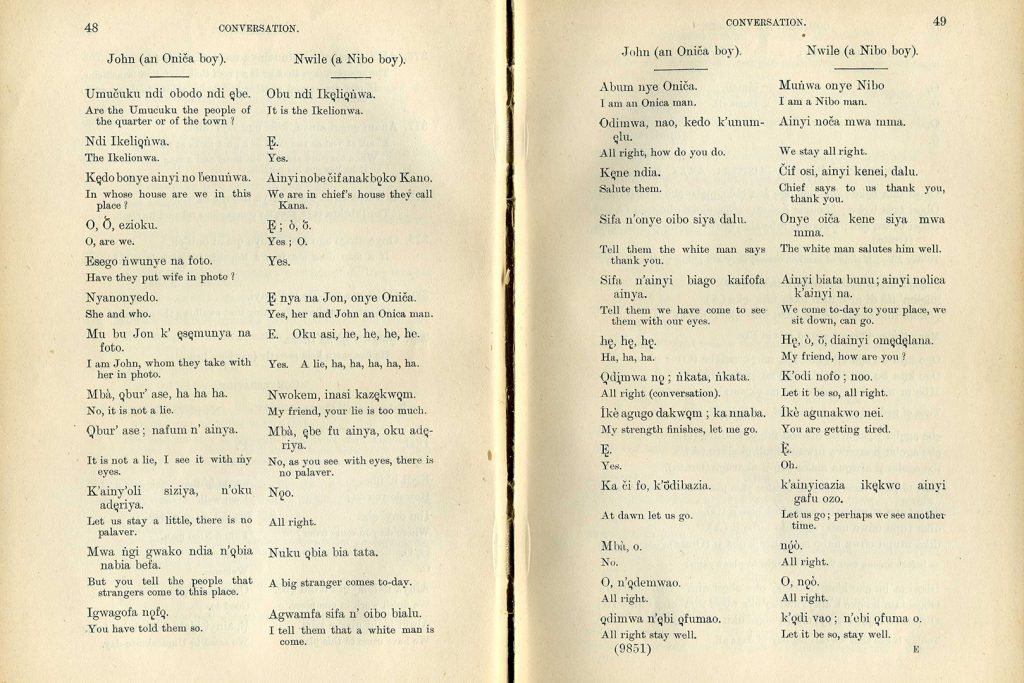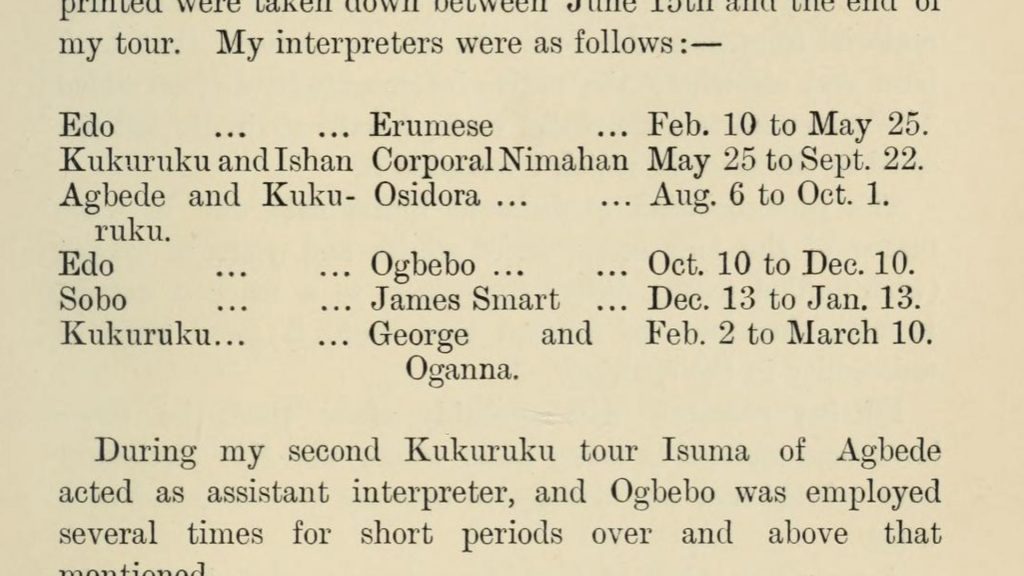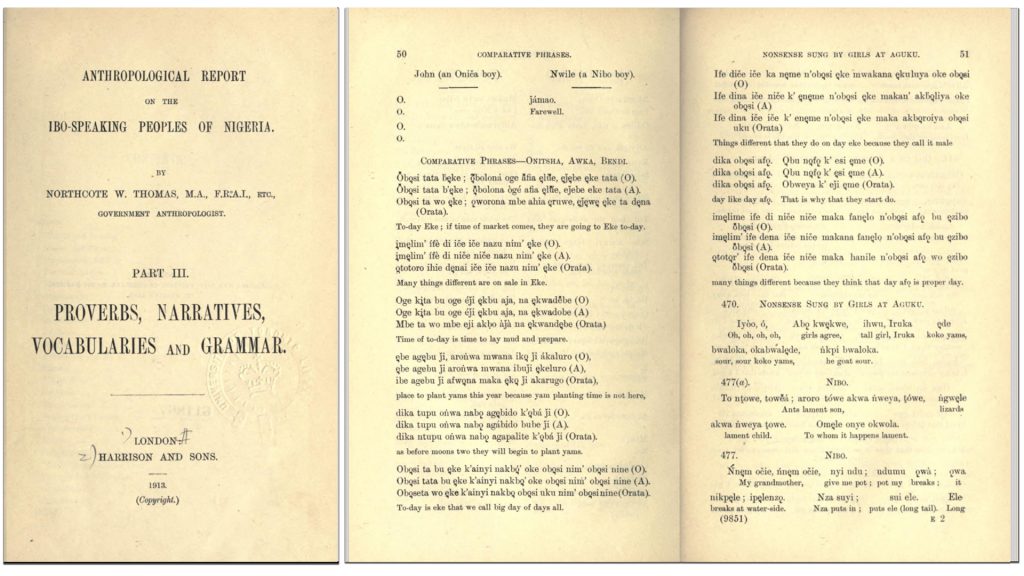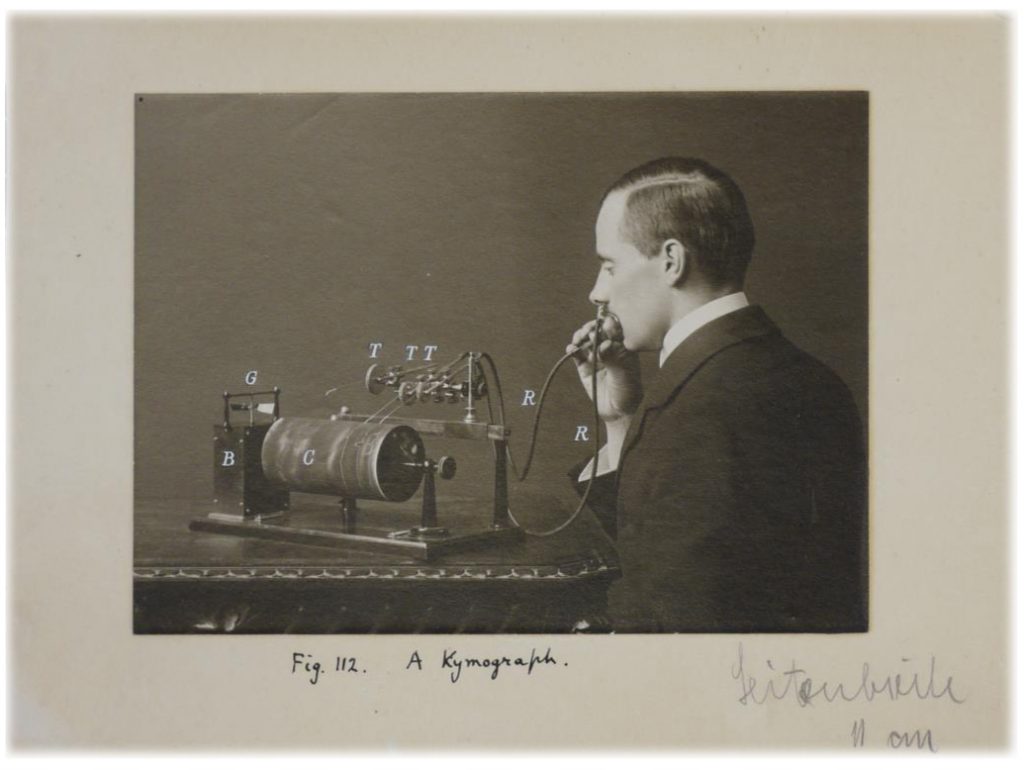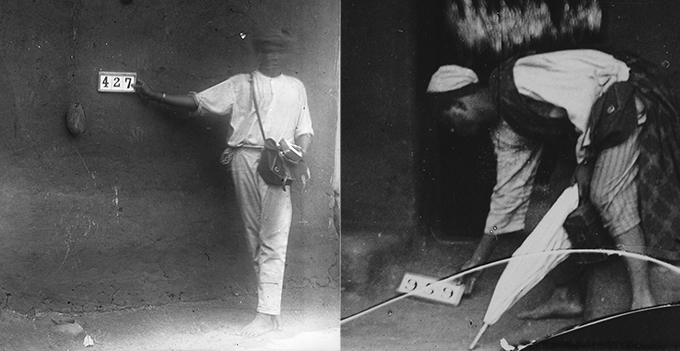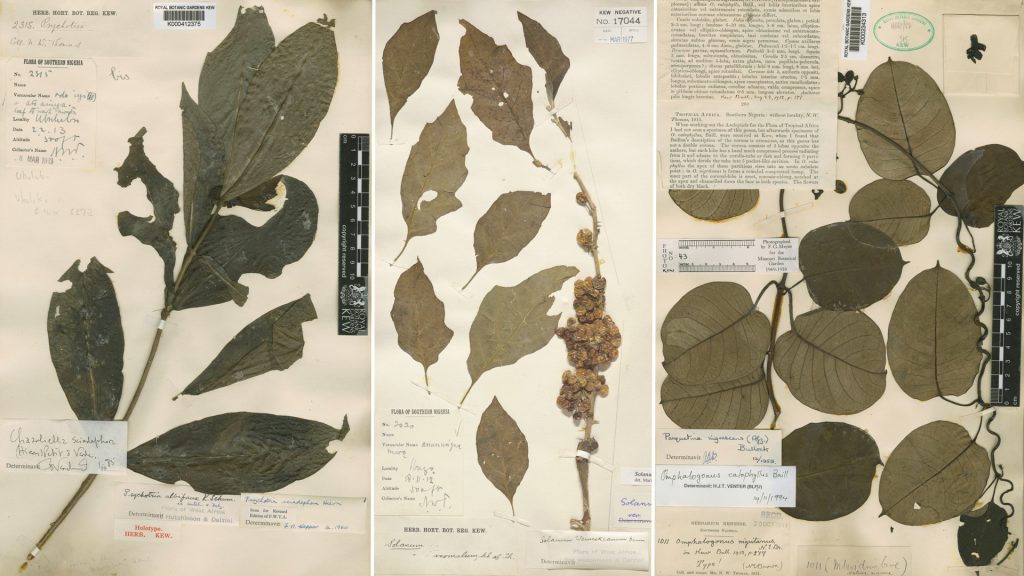
Although the collecting of botanical specimens fell outside the remit of his anthropological surveys, Northcote Thomas devoted increasing energy to this pursuit during his tours in West Africa. Collections made during his final tour, in Sierra Leone, between 1914 and 1915, still constitute one of the most comprehensive reference collections of Sierra Leonean plant species in the world.
Like many aspects of his work as ‘Government Anthropologist’, collecting information about plants was not something Thomas was instructed to do by the colonial authorities, but was rather something he undertook on his own initiative. While his published reports make little mention of botany, Thomas was clearly very interested particularly in the medicinal uses of plants among the people he worked with.

As far as we know, he did not collect actual samples of plants during his 1909-10 survey of Edo-speaking people of Nigeria. He did, however, make detailed notes on indigenous names of plants and their uses. Unfortunately, due to changes in pronunciation and the idiosyncrasies of Thomas’ phonetic transcriptions, it is not easy to identify species based on the vernacular names of plants written in Thomas’ notes. We were, however, able to identify ova, in Thomas’ list of medicinal plants in Otuo, North Edo, which is recorded as being used as a ‘strengthening medicine’ for babies. ‘The child’, Thomas explains, ‘is washed with it and drinks it for three months. Then the leaf is put in the girdle’. According to a 2017 article by Prof Idu MacDonald and colleagues at the University of Benin concerning ‘indigenous plants used by the Otuo tribe’, ova is identified as Alchornea cordifolia, which is widely used in traditional medicine throughout sub-Saharan Africa.
Thomas began collecting samples of plant specimens during his next tour, in 1910-11, in what was then the Awka District of Southern Nigeria – corresponding approximately to present-day Anambra State. Having assembled an initial collection of about 350 specimens from Awka and Agulu, Thomas sent these to the Royal Botanic Gardens, Kew, so that their scientific names could be determined. It appears that he intended to include these lists of vernacular name, scientific name and local uses in his reports on the Igbo-speaking peoples of Nigeria.

In a letter of 11th May 1911 to David Prain (1857-1944), Director of the Royal Botanic Gardens, Thomas apologises for the poor quality of the specimens. ‘I fear most of them are in very bad condition’, he writes, ‘as I have been having four tornadoes a week for some time and mist round my tent till 10am every day, so that nothing can be kept dry.’ He also explains that he lacks the technical knowledge and equipment to preserve seeds in such conditions, and seeks advice and materials so that specimens can be kept in better order in the future.
Over the following months, Thomas sends further batches of specimens to Kew for identification. In one letter he notes that ‘the collections are largely made by my junior interpreter’. Alas, we do not know the name of this interpreter and, typical of colonial era scientific practice, the specimens are all recorded under Thomas’ name. Thomas did seek to have this interpreter employed to continue the work of collecting during the following dry season at a cost of £20, including carriers. Neither the colonial government of Southern Nigeria nor Kew was disposed to fund this. In a letter from Arthur W. Hill (1875-1941), Assistant Director at the Royal Botanic Gardens, an offer was, however, made to purchase specimens collected under Thomas’ supervision at ‘the usual rate of £2 per 100 specimens’ – so long as they were in good condition and properly labelled.

At Kew, the actual work of identifying the scientific names of the plant specimens sent by Thomas was most likely undertaken by John Hutchinson (1884-1972), who was then assistant in the Tropical Africa section. In an internal memo attached to his determination list, Hutchinson notes that many of the specimens could not be identified due to the absence of flowers or fruits, which, in addition to leaves, are frequently necessary to determine species.
Prain conveyed Kew’s enthusiasm that Thomas should continue to send specimens during his subsequent tours and provided further guidance on botanical collecting practice. Templates were prepared for labels to encourage Thomas and his assistants to improve the quality of their documentation at the time of collection. These were adapted from a design included in a 1908 edition of Kew’s Bulletin of Miscellaneous Information, dedicated to ‘The Useful Plants of Nigeria’.

Equipped with better knowledge about botanical collecting practices and materials, the specimens and associated information assembled during Thomas’ 1912-13 tour focusing on Igbo-speaking communities in the Asaba District (the north-east area of present-day Delta State) and 1914-15 tour of Sierra Leone were of much better quality. Thomas continued to send batches to Kew, where they were identified, mounted on cards and accessioned into its Herbarium – a vast reference collection of the world’s plant species.

Despite gathering knowledge about West African plants and their uses on a more systematic basis, Thomas’ ambition to publish his findings on indigenous botanical knowledge seems not to have come to fruition. In April 1915, however, as Thomas’ anthropological survey of Sierra Leone drew to a close, the authorities at Kew suggested to Thomas that they collaborate on a definitive handbook on the Flora of Sierra Leone. Envisaged was a book that would appeal to a broader public rather than only botanical experts, and to include many illustrations by John Hutchinson that would make the volume ‘attractive and valuable’. A copy of Fawcett and Rendle’s Flora of Jamaica (1910) was sent to Thomas to give him an idea of what was proposed.
The letter, probably from David Prain, provides an indication of the significance of the collections assembled by Thomas and his assistants in Sierra Leone: ‘Thanks to your zeal and perseverance … I do not think there is anywhere so complete a collection representing the flora of Sierra Leone as there is now at Kew’. The letter continues: ‘We have had few collectors in Africa who have been so successful as you have been of late in Sierra Leone and I should be very sorry indeed if the opportunity of getting anything really good out of your efforts should be missed’.
While the possibility of the Flora of Sierra Leone was being deliberated, another Kew botanist – Keeper of the Herbarium, Dr Otto Stapf (1857-1933) – drafted a more modest contribution, which was incorporated into Thomas’ Anthropological Report on Sierra Leone (1916) as a ‘Note on the Botanical Features of Sierra Leone’. The Report also includes a glossary of 46 Temne plant names, with scientific determinations – this was a very modest list, given that Thomas documented some 10,654 specimens in his botanical field books from Sierra Leone.

After the First World War, plans for the proposed Flora of Sierra Leone were superseded by a geographically more expansive initiative that was to become the Flora of West Tropical Africa, the first part of which was originally published in 1927 under the editorship of John Hutchinson and John McEwan Dalziel (1872-1948). Correspondence with Thomas from the 1920s survives in the Kew archives, showing that he was consulted from time to time on the Sierra Leonean material while the manuscript was being prepared. The Flora of West Tropical Africa has been revised periodically and remains a major reference work.
After his few intense years employed as Government Anthropologist, Thomas fell into professional obscurity. In the late 1920s he moved to a cottage in the Malvern Hills in Worcestershire. One of the last letters we have found, written by Thomas in August 1928 from his West Malvern address, is to Arthur Hill, who had taken over as Director of the Royal Botanic Gardens, Kew. He thanks Hill for sending him a copy of the newly published Flora of West Tropical Africa, but, in a manner typical of Thomas, then goes on to list typographical errors and misprints relating to his own contributions, including the misprinting of his own initials.
Despite the professional disappointments of his later life, Thomas continued to be interested in the medicinal properties of West African plants. In the early 1980s, the Canadian anthropologist Richard Slobodin (1915-2005) began research for a biography on Thomas. (He has previously written a biography of Thomas’ contemporary W. H. R. Rivers.) It is a project Slobodin did not complete, but one of the snippets of information he obtained from Thomas’ surviving daughter, Flora (1910-91), was that her father grew such medicinal plants in his garden.
Reconstructing Thomas’ Sierra Leone itineraries
As well as their value to botanical and pharmaceutical science, the plant collections assembled during Thomas’ anthropological surveys provide an important resource for assessing environmental change in Southern Nigeria and Sierra Leone. This is a project we hope to pursue with the Royal Botanic Gardens, Kew and colleagues in Nigeria and Sierra Leone in the future. In the meanwhile, it is through the high quality of the documentation of these botanical specimens that we have been able to reconstruct Thomas’ itineraries, particularly during his 1914-15 tour of Sierra Leone.


Through the information on the specimen cards and field books, we have been able to correlate dates and locations, and thereby follow his journey. Furthermore, in preparation for the abandoned Flora of Sierra Leone project, Thomas was asked to provide a sketch-map identifying each of the locations from which the specimens were obtained. This allows us to be certain of locations in cases where the spelling of place names has changed or where there are multiple places with the same name.

This was especially useful in the case of Thomas’ Sierra Leone tour, since his work was largely focused in northern and central Sierra Leone. We learn from the botanical specimens, however, that he spent the last three months of the tour travelling in Mende– and Sherbro-speaking areas of the south. It is likely that he travelled by rail to the southern towns of Bo and Kenema, and then proceeded by foot/hammock to Pujehun, Tomabum, Talia, Gbangbama, Victoria, Kanga, then back to the railway town of Mano, before ending his tour in Freetown at the beginning of April 1915. There are few photographs from this part of his journey, possibly because restrictions caused by the First World War meant that he was unable to obtain new glass plate negatives.
Collecting the world?
Preliminary work for a study of the archives and collections from Thomas’ anthropological surveys was undertaken by Roger Blench and Mark Alexander in the 1980s. While, like Slobodin’s biography, this initiative was not completed, Blench and Alexander began to document the whereabouts of the various collections, and this has been invaluable starting point for the work we have been pursuing in the [Re:]Entanglements project.
In an article published in The Nigerian Field entitled ‘The Work of N. W. Thomas as Government Anthropologist in Nigeria’ (1995), Blench reports that many of the specimens collected by Thomas (or, as we now know, his assistants) were no longer traceable at Kew. Blench states that many of the Thomas specimens were duplicates already in the collection and that they were exchanged with other herbaria around the world. ‘Apparently’, he writes, ‘no record was kept of the destinations of these specimens nor was a record kept of the information recorded on the cards. As a result, much of the data was effectively lost, and many of Thomas’s vernacular names can no longer be tied to specimens’.
Perhaps as a result of Blench’s inquiries, Kew botanist Humphrey Burkhill conducted a thorough survey of the Thomas specimens at Kew as compared with those listed in Thomas’ field books. In an internal memorandum he reported that only 55% of the Nigerian collections and 36% of the Sierra Leonean collections could be located. In response, Nigel Hepper, another specialist in African plants at Kew, argued somewhat defensively that the problem lay in Thomas’ lack of knowledge of botanical practice of collecting duplicates under the same number, so that the total of 11,415 specimens from Thomas’s surveys represented far fewer different species and included a great many duplicates. Hepper explained that it was indeed standard practice of herbaria to exchange duplicates, and that ‘if some with different vernaculars were distributed then that was the cost of dealing with such large numbers’.
It appears then that the sheer scale of the collections, resulting from Thomas’ remarkable ‘zeal and perseverance’, undermined their usefulness. The same can be said of other aspects of Thomas’ work and this partly accounts for why, despite the quantity of materials produced, Thomas’ anthropological surveys produced little knowledge that could be practically applied in colonial governance. Remarkable though they were, Thomas’ endeavours speak of the hubris of colonial science and its project of collecting and documenting the world; a project that was destined to fail.
Further reading
- Blench, R. (1995) ‘The work of N. W. Thomas as Government Anthropologist in Nigeria’, The Nigerian Field 60: 20-28.
- Fawcett, W. and Rendle, A. B. (1910) Flora of Jamaica. London: British Museum.
- Hutchinson, J. and Dalziel, J. M. (1927-36) Flora of West Tropical Africa, 2 vols. London: Crown Agents for the Colonies.
- MacDonald, I., Ovuakporie-Uvo, O. and Ima-Osagie, O. S. (2017) ‘Indigenous plants used by the Otuo tribe of Owan East Local Government Area, Edo State, Nigeria’, Journal of Medicinal Plants for Economic Development 1(1): 1-10.
- Slobodin, R. (1997) W. H. R. Rivers: Pioneer Anthropologist, Psychiatrist of The Ghost Road, 2nd edition. Stroud: Sutton.
Many thanks to Kiri Ross-Jones, Archivist and Records Manager at the Royal Botanic Gardens, Kew, for her assistance while researching this article.

